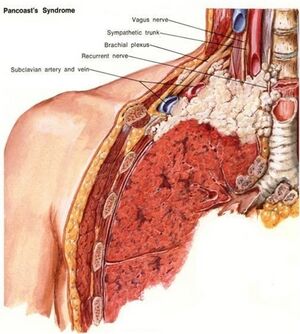Pancoast Tumor: Symptoms, Diagnosis, and Treatment
Pancoast tumor, a rare form of lung cancer, can have a significant impact on one’s health and well-being. This article aims to shed light on this condition, providing insights into its symptoms, diagnostic process, and treatment options. By understanding Pancoast tumors better, individuals can empower themselves with knowledge for early detection and effective management.
Unveiling Pancoast Tumor Symptoms:
Recognizing the symptoms of a Pancoast tumor is crucial for timely intervention. Common indicators include persistent shoulder pain, arm weakness, and unexplained weight loss. Individuals may also experience severe pain in the shoulder or upper arm, often radiating down the arm. This pain might intensify at night, making it uncomfortable to sleep on the affected side. As the tumor affects nearby nerves, it can lead to a group of symptoms known as Horner’s syndrome, characterized by drooping eyelids, constricted pupils, and reduced sweating on one side of the face.

The Diagnostic Journey: Identifying Pancoast Tumors:
Diagnosing a Pancoast tumor involves a comprehensive approach to accurately assess the condition. Healthcare providers start with a detailed medical history and physical examination, focusing on the reported symptoms. Imaging tests such as X-rays, CT scans, and MRI scans provide detailed views of the tumor’s location and size. These tests help determine if the tumor has spread to nearby structures.
Pancoast Tumor Types and Staging:
Pancoast tumors are classified based on their location and the structures they affect. The most common type is a non-small cell lung cancer (NSCLC) known as squamous cell carcinoma. Staging determines the extent of the tumor’s spread, guiding treatment decisions. Pancoast tumors are typically categorized as stages IIIB or IV, indicating their advanced nature. Staging helps medical teams determine the best approach to address the tumor while considering the individual’s overall health.
Treatment Approaches for Pancoast Tumors:
The management of Pancoast tumors necessitates a multi-modal treatment approach, often involving a combination of therapies. These include surgery, radiation therapy, and chemotherapy. The treatment plan is tailored to the individual’s condition, tumor stage, and overall health.
Surgery and Innovative Techniques:
Surgery is a cornerstone of Pancoast tumor treatment, especially in cases where the tumor hasn’t spread extensively. Depending on the tumor’s size and location, surgical options include wedge resection, lobectomy, or pneumonectomy. Advances in surgical techniques, such as minimally invasive procedures, contribute to reduced post-operative discomfort and quicker recovery times. Surgical intervention aims to remove the tumor while preserving lung function as much as possible.
Navigating Radiation and Chemotherapy:
Radiation therapy and chemotherapy play crucial roles in treating Pancoast tumors, either as standalone treatments or in combination. Radiation targets the tumor with high-energy rays, aiming to shrink its size and slow down its growth. Chemotherapy, on the other hand, uses powerful drugs to target cancer cells throughout the body. These treatments can help shrink tumors before surgery or manage cancer that has spread beyond the primary site.
Integrative Care and Supportive Measures:
Managing the physical and emotional aspects of Pancoast tumor treatment is essential. Integrative care approaches, such as nutritional counseling, pain management, and psychological support, can enhance overall well-being. Supportive measures include engaging in activities that promote relaxation and stress reduction. These complementary strategies contribute to a comprehensive approach to treatment and recovery.
Recovery, Rehabilitation, and Follow-Up:
After completing treatment, individuals enter the recovery phase, which involves regaining strength and adjusting to post-treatment changes. Depending on the treatments received, rehabilitation might be recommended to improve lung function and physical well-being. Regular follow-up appointments with healthcare providers are essential for monitoring progress, addressing any concerns, and detecting potential recurrence.
Living with Hope: Success Stories and Outlook:
Throughout the journey of managing Pancoast tumors, many individuals have triumphed over challenges and achieved positive outcomes. Inspirational stories of courage and resilience serve as beacons of hope for those navigating similar paths. These narratives remind us that with the right medical care, a strong support network, and a positive mindset, facing a Pancoast tumor diagnosis can lead to brighter days ahead.
FAQs about Pancoast Tumors
Can Pancoast tumors be benign?
Pancoast tumors are typically malignant (cancerous), but benign tumors can also occur in the same location.
Are Pancoast tumors common?
Pancoast tumors are relatively rare, accounting for a small percentage of lung cancer cases.
What causes Pancoast tumors?
The exact cause of Pancoast tumors is not fully understood, but smoking and exposure to certain environmental factors are potential risk factors.
Can Pancoast tumors be treated without surgery?
Depending on the tumor’s size and location, non-surgical treatments like radiation and chemotherapy may be used alone or in combination.
What are the long-term effects of Pancoast tumor treatment?
Long-term effects can vary, including changes in lung function and potential side effects of treatments. Regular follow-up helps monitor any lasting effects.
What are the symptoms of a Pancoast tumor?
Common symptoms include persistent shoulder pain, arm weakness, unexplained weight loss, and severe shoulder or upper arm pain that may worsen at night.
How are Pancoast tumors diagnosed?
Diagnosis involves medical history review, physical exams, imaging tests (X-rays, CT scans, MRI), and biopsies to confirm the presence of cancer cells.
What are the treatment options for Pancoast tumors?
Treatment includes surgery, radiation therapy, and chemotherapy. The approach depends on tumor size, location, and individual health.
How do radiation and chemotherapy help with Pancoast tumors?
Radiation shrinks the tumor using high-energy rays, while chemotherapy targets cancer cells throughout the body, aiding in tumor reduction and management.
Is recovery possible after Pancoast tumor treatment?
Yes, recovery is possible. After treatment, individuals enter a phase of regaining strength and adjusting to post-treatment changes. Regular follow-up is crucial for monitoring progress and detecting any recurrence.
Conclusion:
Navigating a Pancoast tumor diagnosis requires both medical expertise and personal resilience. By understanding the symptoms, diagnostic process, treatment options, and recovery journey, individuals can approach their health with confidence and hope. Early detection, proactive treatment, and ongoing support contribute to improved outcomes and quality of life.




